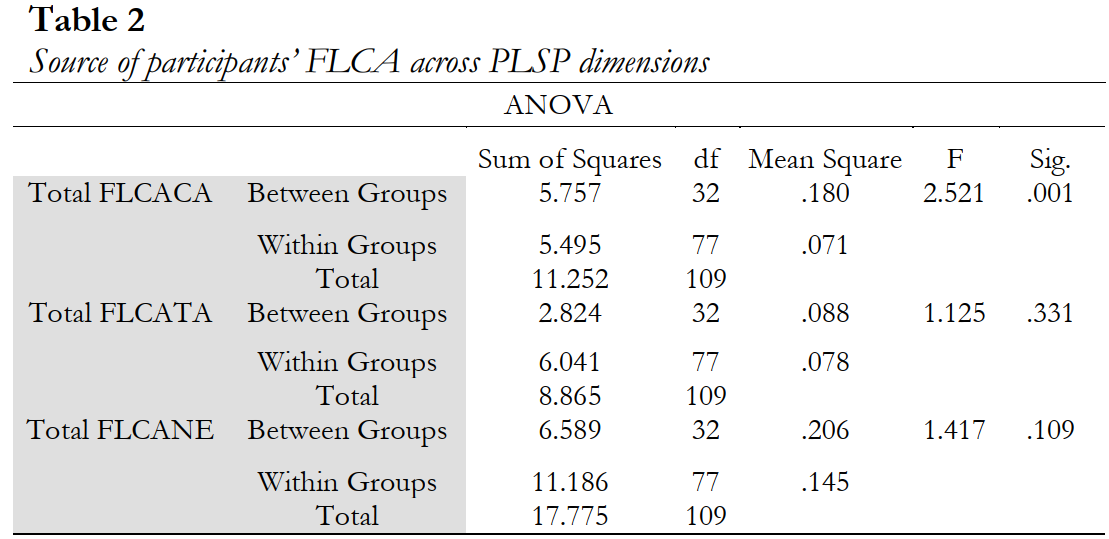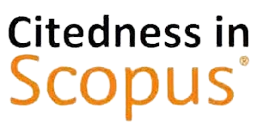Exploring the relationship between perceptual learning style preferences (PLSP) and foreign language class anxiety (FLCA)
DOI:
https://doi.org/10.33474/j-reall.v5i1.21443Keywords:
foreign language class anxiety, high school students, learning style preferenceAbstract
The study investigating a relationship between perceptual learning style preferences (PLSP) and foreign language class anxiety (FLCA) remains limited, particularly regarding specific learning styles most impacted by FLCA and interventions to be tailored to reduce English class anxiety. The study examined the relationship between PLSP and FLCA among 110 grade eleven Mettu Comprehensive High School students. The study employed a PLSP questionnaire (Pashler et al., 2009) and an FLCA questionnaire (Horwitz et al., 1986) as the instruments. Data were collected, statistically analyzed, and interpreted using SPSS version 26. The study’s findings revealed that most participants' FLCA fell to the average higher level while those with group (PLSA-G) PLSP exhibited the least FLCA compared to participants with the individual (PLS-I) with the highest FLCA among the six dimensions of PLSP. Communication anxiety (FLCA-CA) significantly and fear of negative evaluation (FLCA-FNE) broadly were found to be the major sources of the participants’ sources of FLCA among its three dimensions in the scale. Furthermore, results of One-way ANOVA confirmed that PLSP is significantly and moderately related to FLCA. It was inferred that the constructs PLSP and FLCA play significant roles in the context of EFL teaching. Therefore, EFL instruction needs to address these variables as determinants of the learners’ success, and if meaningful pedagogical room is to be allocated, teaching practices need to pay attention to such. This area of exploration can lead to significant advancements in EFL pedagogy, creating a more inclusive and successful learning experience for students.
References
American Psychological Association (2020). Construct. In APA Dictionary of Psychology (3rd ed.). https://dictionary.apa.org/
Armstrong, T. (2009). Multiple intelligences in the classroom. Virginia: ASCD. doi: 10.1002/9781416628382.ch1
Bransford, J. D., Brown, A. L., & Cocking, R. R. (Eds.) (2000). How people learn: Brain, mind, experience, and school (Expanded ed.). National Academies Press. https://doi.org/10.17226/9853
CAST. (2011). Universal design for learning guidelines version 2.0. Retrieved from http://udlonline.cast.org/udl/20resources/udl-guidelines/v2/CAST_UDL_Guidelines_v2.0.pdf DOI: 10.1037/14646-000
Chamorro-Premuzic, T., Grego, S., & Diener, E. (2016). Learning strategies and second language proficiency: A meta-analysis. Applied Psychology, 65(4), 477-508.
Clark, L. A., & Watson, D. (1995). Trait psychology: Historical roots and the centrality of trait language. Psychological Science, 6(2), 341-345. DOI: 10.1111/j.1467-9280.1995.tb00531.x:
Coffield, F., Moseley, D., Hugo, H., & Macdougall, J. (2004). Learning styles and pedagogy in post-16 learning: A systematic and critical review. Learning and Skills Research Centre.
Dornyei, Z. (2005). The psychological mechanisms of second language acquisition: Insights from research and theory. Psychology Press. doi: 10.4324/9780203427388
Dunn, R., Griggs, S., & Howe, P. (2014). Learning styles: Overcoming the myths. Educational Psychologist, 49(4), 187-201. https://www.sciencedirect.com/science/article/abs/pii/S0360131516302482
Eggen, P., & Kauchak, D. P. (2018). Educational psychology: Eighth edition. Pearson Education Limited. DOI: https://www.vitalsource.com/products/educational-psychology-john-w-santrock-v9781266203381
Eid, M., & Diener, E. (Eds.). (2006). Handbook of multi-method measurement in psychology. Washington, DC: American Psychological Association. https://psycnet.apa.org/doi/10.1037/11383-000
Fisher, D., Frey, N., & Gonzalez, J. (2018). Visible learning for literacy, grades K-12: A comprehensive guide to differentiated instruction. Corwin. doi:10.1002/9781119562479
Fleming, N. D. (2001). Teaching and learning styles: VARK strategies. Christchurch, New Zealand: Author.
Gardner, H. (1993). Multiple intelligences: Theory into practice. New York, NY: Basic Books.
Gay, G. (2010). Culturally responsive teaching: Theory, research, and practice (2nd ed.). New Yorl: Teachers College Press.
Hampson, S. E., & Goldberg, L. R. (2006). A first large cohort study of personality trait stability over the 40 years between elementary school and midlife. Journal of Personality and Social Psychology, 91(4), 763-779. https://doi.org/10.1037/0022-3514.91.4.763
Honey, P., & Mumford, A. (1986). The manual of learning styles. Maidenhead: McGraw-Hill.
Horwitz, D. W., Horwitz, E. K., & Cope, W. (1986). The construct of anxiety in second language acquisition: A review of the literature. Language Learning, 36(2), 125-162.
Kim, J.H., Yu, B.H., Oh, K.S., Yang, J.C., Kim, Y., Lee, S.Y., & Lim, Y.J. (2004). A validation study of Korean Anxiety Sensitivity Index-Revised (ASI-R). Journal of Korean Neuropsychiatry Association, 43, 54-61.
Kolb, D. (1984). Learning Style Inventory. Boston, MA: McBer.
Lazear, D. (1991). Seven ways of teaching: The artistry of teaching with multiple intelligences. Palatine, IL: IRI Skylight Publishing Inc.
Li, S., Zhang, Y., & Liu, X. (2023). The effects of language learning strategies and self-efficacy on foreign language learning achievement: A structural equation modelling approach. System, 133, 102722.
Lim, C. S., & Cole, M. (2018). Vygotsky's Zone of Proximal Development: Learning through Reciprocal Scaffolding. Educational Psychologist, 53(3), 145–161. DOI: 10.1080/00131644.2018.1444329
Linnenbrink-Garcia, L., Pintrich, P. R., & Matsumoto, D. (2019). Individual differences in academic performance: A review of social-emotional learning measures. Journal of Educational Psychology, 111(7), 1043-1062. doi: 10.1037/edu0000340
Lucas, R. E., & Donnellan, M. B. (2009). If the person-situation debate is really over, why does it still generate so much negative affect? Journal of Research in Personality, 43, 146-149.
Luo, H. (2013). Foreign language anxiety: Past and future. Chinese Journal of Applied Linguistics, 36(4), 1-12.
MacDonald, R. B., & Wong, B. L. (2003). The effectiveness of the learning styles questionnaire revisited. Educational Psychology Review, 15(1), 3-24.
MacIntyre, P. D., & Gardner, R. C. (2019). The construct of foreign language classroom anxiety revisited: The role of affective states in language learning. Modern Language Journal, 103(1), 167-185. https://doi.org/10.1111/modl.12722
McDonald, R. P. (1999). Test theory: A unified treatment. Mahwah, NJ: Erlbaum. https://doi.org/10.4324/9781410601087
Mercer, N. (2000). The contribution of talk to learning: Developments in research. Educational Psychologist, 35(3), 121-139. doi:10.1207/S15326987EP3503_2
Messick, S. (1995). Validity of psychological assessment: Validation of inferences from persons' responses and performances as scientific inquiry into score meaning. American Psychologist, 50(2), 741-749. https://psycnet.apa.org/doi/10.1037/0003-066X.50.9.741
Metcalf, D. (2017). Universal design for learning: Theory and practice. Thousand Oaks, CA: SAGE Publications. 10.4135/9781506379834
Niemiec, C. P., & Ryan, R. M. (2009). Autonomy, competence, and relatedness in the classroom: Doing more than creating a good climate. Journal of Educational Psychology, 101(4), 731-742. https://10.1177/0022066308329138
Oxford, R. (1990). Language learning strategies: What every teacher should know. New York, NY: Newbury House.
Pascoe, A. (2017). Multiple intelligences in education. Cambridge University Press. DOI: 10.1017/9781316620239
Pashler, H., McDaniel, M., Rohrer, D., & Bjork, R. (2009). Learning styles: Concepts and evidence. Psychological Science in the Public Interest, 10(3), 105-166. DOI: 10.1111/j.1539-6053.2009.01038.x
Sternberg, R. J. (2012). The triarchic theory of successful intelligence. In D. P. Flanagan & P. L. Harrison (Eds.), Contemporary intellectual assessment: Theories, tests, and issues (3rd ed., pp. 156–177). The Guilford Press.
Pritchard, A. (2009). Ways of learning: Learning theories and learning styles in the classroom. New York, NY: Routledge. https://doi.org/10.4324/9781315852089
Rahman, N. A. (2016). Learner styles and EFL teaching: A case study of Bangladeshi secondary school learners. Journal of Applied Linguistics and Language Teaching, 1(2), 1-12. doi: 10.47803/jallt.v1i2.5
Reid, J. M. (2009). Learning styles and English classroom anxiety. TESL-EJ, 13(1), 1-16.
Reid, J. (1995). Learning styles in the ESL/EFL classroom. Boston, MA: Heinle & Heinle.
Ryan, R. M., & Deci, E. L. (2017). Self-determination theory: Basic psychological needs in motivation, development, and wellness. Guilford Publications. DOI: 10.1037/0022-0663.92.4.170
Schmidt, R., Gülgönen, B., & Dörnyei, Z. (2022). Individual differences in language learning: A selective review of recent research. Language Learning, 72(2), 339-378.
Soto, C. J., John, O. P., Gosling, S. D., & Potter, J. (2008). The developmental psychometrics of big five self-reports: Acquiescence, factor structure, coherence, and differentiation from ages 10 to 20. Journal of Personality and Social Psychology, 94(4), 718-737. https://doi.org/10.1037/0022-3514.94.4.718
Suprihadi & Kohayani, A. (2016). Relationship between gender, subject preference and learning styles. A Journal of Culture, English Language Teaching & Literature, 16(2) http://dx.doi.org/10.24167/celt.v16i2.583
Waller, N. G., & Meehl, P. E. (1998). Taxonomic diagnosis and Cassirer's dictum. Archives of General Psychiatry, 55(2), 102-107. DOI: 10.1001/archpsyc.55.2.102
Widiger, T. A., & Trull, T. J. (2007). Prototypes and the dimensional nature of mental disorders. Psychological Inquiry, 18(2), 187-207. DOI: 10.1080/10478410701569190
Williams, J. M., Healy, M. G., & Clancy, J. (2013). A randomised controlled trial of internet-delivered cognitive bias modification for depression. Journal of Affective Disorders, 151(2), 90-98. https://doi.org/10.1016/j.jad.2013.06.002
Yashima, T., & Roland, R. (2010). Learner autonomy in language learning: Towards a framework for EFL learner training. RELC Journal, 41(3), 289-313. doi: 10.1177/0034547X10379382
Zhang, L. J. (2001). Exploring variability in language anxiety: Two groups of Prc students learning ESL in Singapore. RELC Journal, 32(1), 73-91. http://dx.doi.org/10.1177/003368820103200105

Downloads
Published
How to Cite
Issue
Section
License
Copyright (c) 2024 Berhanu Firissa, Alamirew Gebremariam

This work is licensed under a Creative Commons Attribution 4.0 International License.
Authors who publish this journal agree to the following terms:
- Authors retain copyright and grant the journal right of first publication with the work simultaneously licensed under a Creative Commons Attribution License that allows others to share the work with an acknowledgement of the work's authorship and initial publication in this journal.
- Authors can separately make additional contractual arrangements for non-exclusive distribution published by the journal (e.g., publish it in a book), with an acknowledgement of its initial publication in this journal.
- Authors are allowed and encouraged to send their work via online (e.g., in the institutional repositories or their website) after published by the journal.





















